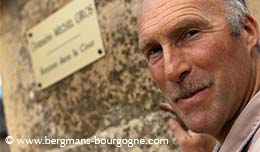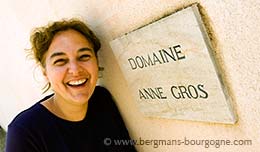
have no regrets. Especially now when the bottles end up on tables around the world. You could say that you sell a part of yourself.
Maxime Cottenceau in Buxy has never been interested in just growing grapes. He wants to paint the whole picture, primarily with Montagny colours.
– Not going all the way was not my thing, he continues. I do everything myself here at the domaine. Filter, bottle, you name it. There is no exterior help.
It was in January 2018 that Domaine Cottenceau came to life. Maxime Cottenceau’s parents were about to end their contract with the local cooperative, Cave des Vignerons de Buxy, and Maxime himself had been working for Vincent Dureuil at Domaine Dureuil-Janthial in Rully since 2015.
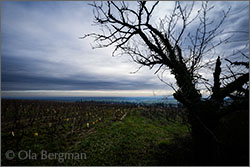 – I couldn’t find any vineyards for my own domaine, says Maxime Cottenceau. My parents said they would pull out part of their vineyards from the cooperative in order to help me. So thanks to them I got my white Givry and the Montagny premier crus Les Vignes Longues, Les Bassets, Mont Cuchot and Vignes du Soleil.
– I couldn’t find any vineyards for my own domaine, says Maxime Cottenceau. My parents said they would pull out part of their vineyards from the cooperative in order to help me. So thanks to them I got my white Givry and the Montagny premier crus Les Vignes Longues, Les Bassets, Mont Cuchot and Vignes du Soleil.
But getting the project off the ground was far from easy. The 2018 harvest was sold off to négociants in order to maintain the cash flow. Then in 2019 half the harvest was lost because of the frost. 2020 suffered from drought and the following year saw the frost taking 90 per cent of the harvest.
 – 2022 was OK, says Maxime Cottenceau. If I make 40-45 hl/ha I’m happy. At the beginning of the harvest there wasn’t much juice in grapes. Luckily there was some rain at the beginning of the harvest and the domaine was saved.
– 2022 was OK, says Maxime Cottenceau. If I make 40-45 hl/ha I’m happy. At the beginning of the harvest there wasn’t much juice in grapes. Luckily there was some rain at the beginning of the harvest and the domaine was saved.
Domaine Cottenceau grew to cover seven and a half hectare. But already early on Maxime Cottenceau began to change things around. In 2021 he sold some of his aligoté, Mercurey and crémant vineyards. They were all too small and too far away from the winery to be worth the drive there.
– At the same time, I found some other vineyards that year – Bourgogne blanc, Montagny Les Préaux, Montagny Les Dazés and Montagny premier cru La Mouillière. There was also a bit of Bourgogne rouge in Les Chazelles. So for a short period of time in 2021 I had seven and a half hectare. When I sold the vineyards I had five and a half hectares left, and in 2023 I took on some aligoté from my parents, in Le Bas des Chailloux and in Les Beaux Champs, planted in 1946-1947. So now I have almost 6.20 ha. At the moment I don’t want to have more vineyards, even if my parents have a lot of vineyards. They still have 22 hectares.
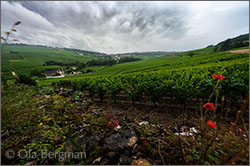 The winery was built in 2019. You’ll find it on the southern tip of the town, where the road to Cluny cuts through the Montagny vineyards.
The winery was built in 2019. You’ll find it on the southern tip of the town, where the road to Cluny cuts through the Montagny vineyards.
The Montagny appellation is the southernmost of the Côte Chalonnaise appellations. It is split between four communes – Buxy, Montagny-lès-Buxy, Jully-lès-Buxy and Saint Vallerin – and covers about 300 hectares, both village appellation and premier crus included.
The vineyards of Domaine Cottenceau are a cross section of the appellation, from Les Vignes Longues at the northern end to Les Dazés at the opposite end.
 – Everything is vinified in the same way, says Maxime Cottenceau. There is no difference between the Bourgogne Aligoté, Les Bassets or Les Vignes Longues. I use 30 per cent new oak. Light filtration, using a lenticular filter. Bottling is done by gravity. The wines stay a year in barrel and eight months in stainless steel tanks. I no longer use débourbage (allowing the gross lees to settle out) for my whites. This is because I want to have lots of lees in the barrels, so it can interact with the oxidation.
– Everything is vinified in the same way, says Maxime Cottenceau. There is no difference between the Bourgogne Aligoté, Les Bassets or Les Vignes Longues. I use 30 per cent new oak. Light filtration, using a lenticular filter. Bottling is done by gravity. The wines stay a year in barrel and eight months in stainless steel tanks. I no longer use débourbage (allowing the gross lees to settle out) for my whites. This is because I want to have lots of lees in the barrels, so it can interact with the oxidation.
– In Burgundy it is a lot about protecting the wine. But the more you protect a wine, the more fragile it becomes. I work with oxidation, which means I leave some air in the barrels. About three litres. I do batonnage (the stirring of the lees) once a month. And there is just a touch of sulphite added.
 The Bourgogne blanc of the domaine comes from Les Verchères in Saint-Vallerin, just next the two village appellation Montagny plots, Les Préaux and Les Dazés. It is facing straight north. The soil is deep. The vines were planted in the 1960s.
The Bourgogne blanc of the domaine comes from Les Verchères in Saint-Vallerin, just next the two village appellation Montagny plots, Les Préaux and Les Dazés. It is facing straight north. The soil is deep. The vines were planted in the 1960s.
– These three lieux-dits are right next to each other, with three different terroirs. For instance, in Les Préaux you’ll find darker clay. Les Dazés is a bit on the exotic side. The rock is more present here. The clay is lighter in colour.. All are vinified in the same manner. What you notice is the difference in terroir.
– The whole area here, with Les Verchères, Les Préaux and Les Dazés, was planted at the same time. It was the father-in-law of Didier Charton, Jean Vacher, who did it.
 There are five Montagny premier crus in the Domaine Cottenceau portfolio – La Moullière, Vignes du Soleil, Mont Cuchot, Les Bassets and Les Vignes Longues.
There are five Montagny premier crus in the Domaine Cottenceau portfolio – La Moullière, Vignes du Soleil, Mont Cuchot, Les Bassets and Les Vignes Longues.
– Les Vignes Longues is the northern limit of Montagny, says Maxime Cottenceau. It is at the very top of the slope, facing straight east. Not quite 300 m in altitude. It is next to Laurent Cognard’s Vieux Chateau. The vines are 18 years old. The particular thing with this is that my father planted and there was a misunderstanding with the nursery owner. He ended up with vines which are very early to ripen and never catch any diseases. Les Vignes Longues is 60 per cent clay and 40 per cent limestone. You often find a lot of clay in Montagny, which is unusual for a white appellation.
Further south, just west of Buxy, is another spot where Maxime Cottenceau has three different vineyards very close to each other and with very different character. The three premier crus Mont Cuchot, Vignes du Soleil and Les Bassets are all squeezed together around the border between Buxy and Montagny-lès-Buxy. Mont Cuchot is higher up on the slope, with the other two just below.
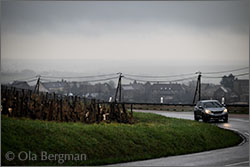 – In Mont Cuchot there is just 30 centimetres of soil above the bedrock, says Maxime Cottenceau. It is facing straight west. In the afternoons you have a nice shade along the vines, which makes life less stressful for the vines. It can be very stressful when it is hot and the bedrock is close to the surface.
– In Mont Cuchot there is just 30 centimetres of soil above the bedrock, says Maxime Cottenceau. It is facing straight west. In the afternoons you have a nice shade along the vines, which makes life less stressful for the vines. It can be very stressful when it is hot and the bedrock is close to the surface.
– Vignes du Soleil is at the bottom of the slope and close to the village appellation vineyards, facing south, south-east. Here you have very dark clay. You have the same type of clay in Les Bassets, but as you move up the slope there is more of the rock from Mont Cuchot. In a way Les Bassets is a blend of Vignes du Soleil and MontCuchot.
La Moullière is the southernmost of all the Montagny premier crus. The parcel of Domaine Cottenceau is yet another vineyard planted by Jean Vacher. It is facing straight south. There is just a thin layer of clay, with blue and white marl. In character the wine Chablis. There is always millerandage there, which means very little juice. So you have a higher skin to juice ratio.
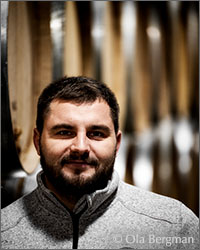 The majority of the vineyards of Domaine Cottenceau are in Montagny. But there are a couple of exceptions. There is the white Givry from Champ Pourot, a lieu-dit at the southern end of the appellation, opposite of the sawmill. It is facing south, with rather poor clay soil. It is a wine which always requires time before the oak is fully integrated.
The majority of the vineyards of Domaine Cottenceau are in Montagny. But there are a couple of exceptions. There is the white Givry from Champ Pourot, a lieu-dit at the southern end of the appellation, opposite of the sawmill. It is facing south, with rather poor clay soil. It is a wine which always requires time before the oak is fully integrated.
The red wines only make up five per cent of the surface area of the domaine.
– For the reds I don’t work with oxidation, says Maxime Cottenceau. I have two plots for Bourgogne rouge. Les Chazelles, which is a Montagny lieu-dit, but also for Bourgogne if planted with pinot noir. And one next to the winery.
– My red Givry comes from the same lieu-dit as the white, Champ Pourot, which is quite vast. The chardonnay vines are not far from the road. Champ Pourot is two slopes. The pinot noir is further in. They ripen later, but that leaves us time to finish the white without stress. I de-stem the reds manually. It requires a lot of time and manpower.
Another seven kilometres further up the Côte Chalonnaise is one more red, the Mercurey La Chagnée. It is in the southern part of the appellation, in the commune of Saint-Martin-sous-Montaigu.
– La Chagnée is facing east, says Maxime Cottenceau. Above Clos Montaigu. Not much soil, so the vines suffers easily from drought. The rock is reddish. This parcel is very early ripening.
© 2025 Ola Bergman










